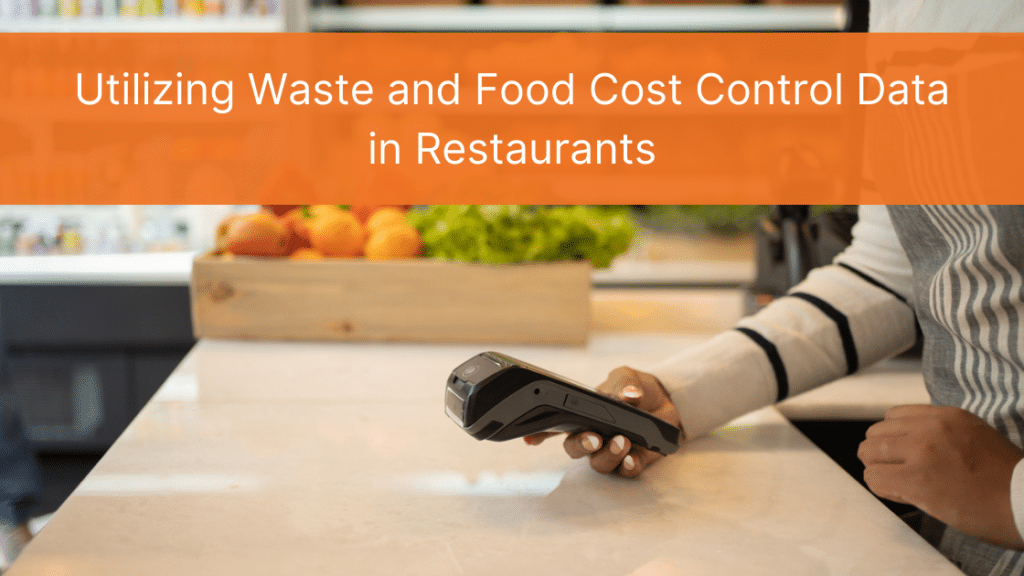In the complex world of restaurant management, waste and food cost control stand as paramount metrics for sustained success. We will unravel the intricacies of understanding, calculating, and optimizing waste and food costs. From deciphering the components of the equation to scrutinizing key data points, let’s delve into the essential elements that define effective cost control in the culinary world.
What is Waste and Food Cost Control?
At its core, waste and food cost control is a strategic approach to managing expenses associated with the procurement, preparation, and disposal of food in a restaurant. It involves monitoring inventory levels, tracking food waste, calculating costs per plate, and nurturing strong supplier relationships. This holistic management ensures not only financial prudence but also promotes sustainability and operational efficiency. Keep an eye on food waste and implement strategies to reduce it. Monitor portion control and inventory to control costs.
How to Calculate It
Food cost is one of the most important elements to consider if you hope to have any chance of running a profitable restaurant. After all, if you don’t know how to calculate food cost, you’ll never know how much you’re spending on the main thing that keeps customers coming through the door—the food.
Food cost is most often calculated as a percentage. Actual food cost gives you a good basic number to work from, but it doesn’t show the whole picture of how much your food cost is actually affecting your bottom line. In other words, when calculating food cost, it’s most helpful to actually know how to calculate food cost percentage to see a holistic view of how your restaurant is doing.
The formula for food cost as a percentage is pretty simple and can be done with a basic calculator (or reporting and analytics software). First, start with the total amount of food sales (usually not including alcoholic beverages). Next, determine the cost of the food used to make the dishes sold. After that, you can calculate it as a percentage. Here’s an example:
Total sales – cost of goods sold = total gross profit
$3,000 – $1,500 = $1,500
[Total gross profit / total sales] * 100 = food cost as a percentage
1,500/3,000 = .5
.5 x 100 = 50%
According to Restaurant Report, an ideal food cost percentage to shoot for is between 28% – 35% of total revenue, though it could vary greatly depending on your individual restaurant. That means 72% – 65% of the money spent by a customer on a menu item could go toward things like paying cooks, paying servers, paying rent, and taking care of any other costs needed to keep your restaurant thriving. Only after that can you see how much of a profit you turned.
As you’re aware, there are several costs to take into account when running your restaurant, so the lower you can get your food cost percentage while still maintaining quality menu offerings, the better.
What to Look for in Waste and Food Cost Control Data
Understanding what to look for in waste and food cost control data is paramount to a restaurant’s success. From scrutinizing inventory levels to tracking food waste, evaluating the cost per plate, and nurturing supplier relationships, here are some actionable ways to effectively reduce waste and food costs.
Inventory Levels
One of the paramount aspects to scrutinize in waste and food cost control data is the state of inventory levels. No one loves taking inventory, but it’s a must-do for a reason. First off, if you’re not even taking inventory, start now! Maintaining an optimal balance in stock is the most important for preventing both overstocking and stockouts. An excess of inventory can lead to unnecessary waste as perishables go unused, while inadequate stock levels may disrupt service and compromise customer satisfaction.
By meticulously examining and adjusting inventory levels, restaurateurs can not only reduce the risk of food wastage but also ensure that they are well-prepared to meet the demands of their clientele.
Implementing inventory software gives employees a consistent template to follow, and aggregates all the information in one place. Be sure to monitor inventory levels regularly to identify excessive stock or items nearing expiration. Regularly assess and record the quantity and value of food items in stock.
Food Waste Tracking
The trash is probably the last place you would think to look, but it is actually a good source of insight. Many restaurant operators adopted a practice known as waste auditing in which a day’s worth of restaurant trash is collected and sorted for analysis. As a team, the kitchen staff records and evaluates the contents, quantities, and reasons for disposal of each item.
Though it may seem tedious, the savings and insight gained from a waste audit is well worth it. Restaurants often discover that they are throwing out food that could actually be repurposed, recycled, or saved for later use. In fact, typically 84% of unused food goes to waste in American restaurants.
Understanding and tracking where and when food is wasted provides valuable insights into operational inefficiencies and areas for improvement. Effective food waste tracking involves a meticulous examination of each stage of food preparation and service. This data not only highlights patterns and trends in wastage but also serves as a compass for implementing targeted strategies to minimize excess.
Restaurants can minimize problems from the start by carefully inspecting all products received from suppliers for spoilage or damage. Ensuring the order is correct and of good quality will reduce the amount of unusable ingredients coming into the restaurant and help maintain an accurate and stable inventory.
Cost Per Plate
A crucial metric to scrutinize is the cost per plate. This metric encapsulates the expenses associated with crafting each menu item, considering not only the cost of ingredients but also labor and overhead. A meticulous examination of the cost per plate provides restaurateurs with a granular understanding of the financial dynamics behind each dish. Through analysis of this data, establishments can pinpoint opportunities for cost optimization, whether through ingredient substitutions, portion adjustments, or strategic pricing.
Supplier Relationships
Your suppliers are one of your most important relationships in the restaurant business, and it’s important that you treat it that way. If you don’t take the time to meet regularly with your suppliers, you won’t find out when there are new products that may be better for you, or get help from your suppliers with optimizing your orders.
A closer look at supplier relationships within allows for strategic decisions regarding procurement, ensuring the sourcing of quality ingredients at optimal prices. An analysis of supplier data unveils opportunities for negotiation, adjustments in ordering quantities, and the cultivation of more sustainable practices. The strength of these alliances is pivotal in optimizing waste reduction and maintaining a cost-effective culinary operation.
Common Waste and Food Cost Control Problems and Solutions
Reducing food waste can yield significant results not only for restaurants, but also the environment. A study by Unilever revealed that 72% of US diners care about how food waste is handled and almost half would be willing to spend more to dine at a waste-conscious restaurant. Simply making small changes to the way purchasing and staff are managed can lead to big payoffs that will benefit everyone.
As establishments strive for excellence, they may encounter common hurdles that demand strategic solutions. Here we will explore the intricacies of prevalent waste and food cost control problems and unveils actionable solutions. From excessive food waste to inefficient ingredient utilization, inaccurate inventory management to high food costs per plate, we’ll unravel the challenges, dissect the underlying issues, and present innovative solutions.
Excessive Food Waste
One of the persistent challenges in the realm of waste and food cost control is the issue of excessive food waste. This problem not only contributes to financial losses but also raises concerns about sustainability. The solution involves implementing robust food waste tracking systems that allow for meticulous monitoring of waste at every stage of the operational cycle.
Additionally, introducing portion control measures, creative repurposing of leftovers, and fostering partnerships with local organizations for food donations are strategic initiatives to curb excess. The following approaches not only transform challenges into opportunities but also sets the stage for a culinary operation that balances excellence with efficiency.
Inventory Management
Implement a first-in, first-out (FIFO) inventory system to ensure older items are used before newer ones. Administering advanced technologies, conducting regular audits, and training staff on accurate recording practices are strategic steps to ensure an optimal balance. By aligning procurement with actual demand, restaurants can reduce overstocking and minimize the risk of perishables going unused.
This proactive approach not only reduces excessive food waste but also fosters a more streamlined and cost-effective culinary operation.
Staff Training
Often, inefficiencies in ingredient utilization and portion control stem from a lack of awareness and skills among kitchen staff and this can lead to excess food waste. But, reducing food waste is not a one person job. The restaurant manager, as well as the entire restaurant staff, need to be on board. Workers should be trained to prepare food properly in order to maximize yield and avoid mistakes.
Assigning more experienced chefs to handle dishes with expensive ingredients will help to minimize waste and costs. Familiarity with recipes will also enable staff to utilize leftover food in other dishes, rather than throwing them away. Educate staff on the importance of waste reduction and how to handle ingredients efficiently. Implement comprehensive restaurant training programs that enlighten the culinary team on efficient ingredient usage, portion management, and creative repurposing of leftovers.
This strategic emphasis on restaurant staff training not only aligns the team with the restaurant’s waste reduction goals but also contributes to a more sustainable and cost-effective culinary operation.
Inefficient Use of Ingredients
The challenge of inefficient use of ingredients often stems from a lack of standardized recipes, inconsistent portioning, inadequate training among kitchen staff, and poor utilization of ingredients impacts cost-effectiveness. The solution involves implementing rigorous training programs that educate staff on precise ingredient usage, introducing standardized recipes, and embracing creative ways to repurpose excess ingredients. Train kitchen staff on efficient ingredient use, adopt standardized recipes, and explore creative ways to repurpose leftover ingredients.
Recipe Standardization
Inconsistent recipes contribute to varying portion sizes and unpredictable ingredient usage, leading to both excess waste and increased costs. Ensuring accurate documentation of recipes and consistent portion control is crucial. Standardized recipes promote uniformity and reduce the potential for cost disparities.
Implement a rigorous system of standardized recipes that detail precise quantities, preparation methods, and serving sizes. This not only streamlines kitchen operations but also ensures consistency in every dish. By adhering to standardized recipes, chefs and kitchen staff can optimize ingredient usage, minimize waste, and maintain a more controlled and cost-effective culinary operation.
Inaccurate Inventory Management
Inaccurate inventory management often results in overstocking, understocking, and financial losses. The solution lies in the implementation of advanced inventory management systems, regular audits, and staff training programs. Adopting technology for precise tracking and leveraging well-trained staff for accurate record-keeping, restaurants can synchronize their inventory levels with actual demand. This strategic approach not only minimizes the risk of excessive food waste but also ensures that ingredients are utilized efficiently, contributing to a more financially prudent and operationally streamlined culinary venture.
Inventory Software
Traditional methods of manual tracking are prone to errors, leading to overstocking, understocking, and financial inefficiencies. While pen-and-paper inventory is better than nothing, restaurants who really want to get food costs under control are turning to inventory software.
The implementation of cutting-edge inventory software brings a digital precision to the pantry, offering real-time tracking, automated alerts for reorder points, and comprehensive analytics. It gives employees a consistent template to follow, and aggregates all the information in one place. Plus, if you get one that includes or integrates with purchasing, you can automate and optimize inventory levels.
Investing in inventory management software can accurately track ingredient levels, reorder points, and expiration dates, and can minimize the risk of inaccurate inventory levels and streamline the entire procurement process.
Regular Audits
Inaccurate inventory management often disrupts waste and food cost control and can lead to food waste and excess costs. Conducting regular inventory audits can help identify discrepancies and allow you to address them promptly. These audits act as the pulse-check for the pantry, offering a periodic examination of stock levels, ingredient quality, and adherence to inventory records.
Consistently scrutinizing physical inventory against recorded levels, restaurants can pinpoint discrepancies, rectify errors, and fine-tune their procurement strategies. This hands-on approach not only minimizes the risk of financial losses through overstocking or understocking but also fosters a culture of accountability within the culinary team.
High Food Cost Per Plate
The challenge of a high food cost per plate poses a significant hurdle in effective waste and food cost control. Did you know that 4 – 10% of food at your restaurant doesn’t even make it to a plate? The main reasons for this include overstocking, overproduction, and spoilage.
Fortunately, all of these problems can be minimized. The first step to reducing food waste is to assess your menu offerings. Using data collected from your point of sale and restaurant analytics software, you can evaluate dishes in terms of demand, volume, and profitability. Meticulously analyze each menu item’s cost composition, encompassing ingredients, labor, and overhead.
You should focus on meals that can be produced effectively and with strong margins, and remove those that result in wasted batches. This strategic emphasis on controlling the cost per plate not only ensures financial viability but also contributes to a more balanced and profitable culinary operation.
Pricing Strategy
Analyzing individual menu items, factoring in ingredient costs, labor expenses, and overheads can be a cost effective strategy for high food costs per plate. Adjust menu prices to align with ingredient costs while remaining competitive. By adjusting pricing based on these insights, establishments can strike a delicate balance between profitability and customer satisfaction.
Menu Reengineering
Evaluate the menu to reduce the use of high-cost ingredients without compromising the dining experience. Meticulous analysis of the menu’s composition, identifying high-cost items and exploring opportunities for cost-effective ingredient substitutions. Examining the profitability and popularity of menu items empowers chefs and managers to make informed decisions regarding pricing and portion sizes.
By conducting a meticulous analysis of each menu item’s contribution to overall profitability and popularity, restaurants can fine-tune their offerings. Dishes that boast higher profit margins and are well-received by diners can be strategically positioned to offset items with narrower margins.
Portion Control
Tackling the challenge of a high food cost per plate requires a meticulous approach to portion control. Implementing a strategic portion control system involves analyzing serving sizes to ensure they align with cost considerations without compromising customer satisfaction. By standardizing portion sizes across the menu, restaurants can not only optimize ingredient usage but also control food costs effectively and ensure that each dish’s ingredients are used efficiently.
Training and Communication
Often-overlooked is the important role training and communication plays when it comes to waste and food cost control. Continuously training and communicating with kitchen staff about the importance of waste reduction and efficient ingredient usage can foster a culture of responsibility, and encourage communication on waste reduction strategies. This ensures that every team member, from kitchen staff to servers, understands the importance of minimizing food waste and adhering to cost-effective practices.
Regular communication channels should be established to encourage feedback, ideas, and insights from frontline staff who often hold valuable observations on operational inefficiencies. By emphasizing training and communication, restaurants can align their teams with waste reduction goals, optimize cost control strategies, and create a cohesive culinary ensemble that not only delights patrons but also contributes to a financially sustainable and operationally efficient establishment.
Sustainability Initiatives
As the culinary world evolves, it is imperative to address your restaurant’s environmental impact. A transformative solution can be implementing sustainability practices, such as composting or donation programs for excess food. These offer a dual benefit of waste reduction and a positive environmental footprint. Ignoring sustainability can impact your restaurant’s reputation and costs.
By incorporating composting programs, embracing recycling, and sourcing locally are strategic steps toward minimizing the ecological impact of restaurant operations. Beyond being an ethical choice, sustainability initiatives also contribute to cost control by optimizing ingredient usage and minimizing waste disposal costs.
By intertwining culinary creativity with a commitment to sustainable practices, restaurants not only reduce their environmental footprint but also foster a reputation for responsible and forward-thinking operations, resonating positively with eco-conscious patrons.
In the world of restaurant analytics, waste and food cost control becomes a keystone for financial resilience, operational excellence, and sustainable culinary practices. By mastering these elements, establishments can not only optimize costs but also contribute to a more efficient, responsible, and profitable culinary landscape.
Stay on Top of Your Restaurant Analytics with SynergySuite
Being able to readily stay on top of your data, and make informed decisions based on that data, it’s absolutely critical to have implemented a quality restaurant reporting and analytics platform like SynergySuite.
Many of the problems and challenges of running a restaurant can be solved or avoided with the right restaurant reporting tools. We offer restaurant analytics software that captures and presents your data in an easy-to-understand dashboard. We make it simple to use your valuable data to save time, improve profitability, and ensure compliance with regulations.
Schedule a demo today to see how SynergySuite can help you take your restaurant business to the next level.





